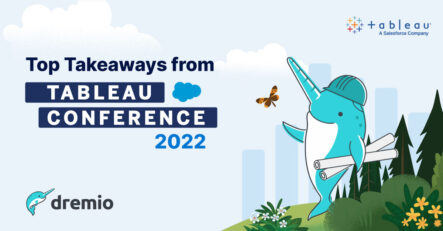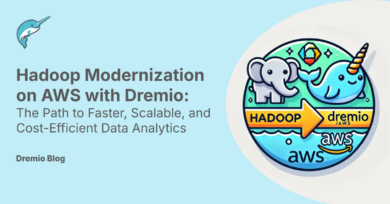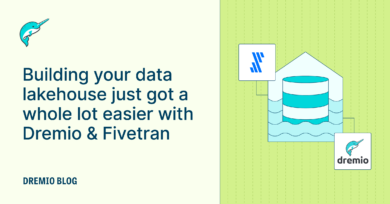9 minute read · May 31, 2022
Top Takeaways from Tableau Conference 2022
· Product Marketing Director, Iceberg Lakehouse Management, Dremio

The Dremio team attended Tableau Conference 2022 (TC22) in Las Vegas, Tableau’s first in-person event since 2019. I was fortunate to be at that last show, and a lot has changed over the past two and a half years. Back then, Tableau’s acquisition by Salesforce was still relatively new. It was certainly new enough that they hadn’t yet fully developed their own “better together” story.
The synergy between Salesforce and Tableau was one of many topics of interest as I attended TC22. Let’s talk a little about what happened in Las Vegas!
Data Everywhere, for Everyone
In the opening keynote, Tableau CEO Mark Nelson discussed the need to get data into the hands of decision-makers. However, it’s getting harder by the day. He used a couple of statistics I’ve used in several presentations from a 2021 IDC Data Culture End User Survey:
- 83% of CEOs want their companies to be data driven, and 80% of CXOs say being an intelligent enterprise is their top priority.
- Yet, only 30% of those surveyed report that they use data to make decisions, and only 27% say they communicate using data.
In order to close the gap between expectations and reality, analytics needs to be fast, easy, and broadly accessible. Of course, we know Tableau addresses some of those issues, but not all of them. More on that a little later.
Although the highlight of the opening keynote was probably the musical number that kicked things off, there were some product announcements that garnered applause from the audience:
- Tableau Accelerators: A number of templates for dashboards that are available on Tableau Exchange, meant to help customers get started visualizing their data quickly.
- Publicly share dashboards: Tableau is giving users the ability to share dashboards with non-licensed Tableau users, further democratizing access to insights. This includes a feature to share dashboards on a public-facing website.
- Advanced management capabilities: Tableau is adding features like customer-managed encryption keys, an Activity Log, and Admin Insights, described as “Tableau for Tableau,” meant to help administrators see and understand Tableau usage and adoption. All of these features are meant to make Tableau more secure and easier to manage.
- Data stories: Stories are intended to help Tableau users understand the data they’re looking at. Data stories uses AI to populate the story, but it’s fully customizable, and it updates dynamically based on how the user interacts with the dashboard.
Einstein + Tableau: Model Builder and Scenario Planner
This announcement deserves its own section, as it represents the “better together” story many of us were waiting for after Tableau’s acquisition by Salesforce. Tableau has been on a mission to help customers see and understand their data, and they’ve done that by building a tool that makes data accessible by a wide range of technical and non-technical data consumers. With Model Builder and Scenario Planner, Tableau is hoping to democratize predictive analytics in the same way. Model Builder is a Tableau-native tool enabling the creation of linear and tree-based predictive models with clicks instead of code, lowering the barrier to entry for analysts who want to see and react to predictive insights.
Scenario Planner allows data consumers to do “what if” modeling to visualize potential outcomes by adjusting one or many variables.
All of this is powered by Einstein, a predictive engine embedded in the Salesforce platform, and it is meant to close the gap between insight and action. Predictive and prescriptive analytics are the holy grail for business leaders, but we know from our conversations with customers that very few AI and ML models make it into production, and most businesses still struggle to understand historical data in a meaningful way. It will be interesting to track the adoption and success stories of both of these features.
Try Dremio’s Interactive Demo
Explore this interactive demo and see how Dremio's Intelligent Lakehouse enables Agentic AI
Supercharge Your Tableau Dashboard with Dremio
Dremio’s own Brett Roberts and NCR’s Nikhil Garg faced the daunting task of filling a room at 9:30 a.m. the morning after Data Night Out, and they delivered! Brett discussed how Tableau users benefit from Dremio. Often, companies who have made an investment in Tableau struggle with adoption due to performance issues related to the underlying architecture. Increasingly, they struggle to access the newest sources of unstructured and semistructured data, such as cloud object storage.
Dremio accelerates query performance and gives customers direct access to the data lake, reducing reliance on data engineering to access data and making data consumers more self-sufficient.
Nikhil shared NCR’s Dremio adoption story. NCR is an enterprise technology company that helps businesses by transforming each moment of the transaction. They’re very successful in a number of verticals, including banking, retail, restaurants, telecommunications, and technology.
As a large organization that has been around for more than a century, NCR was challenged with a sprawling data footprint, and a growing number of data requests. Their Tableau dashboards took significant time to load. To address the performance issues, their teams created large BI extracts, which resulted in multiple copies of the data and no single source of truth.
As they transitioned to a modern data stack, they chose Dremio when they learned they could achieve better performance and re-create data pipelines in days instead of weeks. Ultimately, they saw 10x to 30x improvements in query performance. Their data consumers were able to access data more quickly, which dramatically reduced their time to value. They also reduced “revenue leakage” by identifying opportunities in the customer lifecycle for cross-sell, upsell, and support and service.
Dremio and Tableau Close the Data Gap Together
My key takeaway from TC22 is that Dremio and Tableau have the same mission. Data is more important to businesses than ever, but it’s getting harder and harder to use. Dremio accelerates time to value and provides simple access to the fastest-growing data volumes with an open lakehouse architecture. Dremio powers the Tableau experience so that data consumers don’t have to wait weeks or months for key data-driven insights. Tableau is adding features that empower more and more business users across the organization to move from insight to action quickly.
An easy and open data lakehouse architecture, combined with a powerful platform for exploring and communicating with data, can help businesses close the data gap.
Try It Today!
To see Tableau and Dremio in action, sign up for the Forever Free tier of Dremio Cloud in your own AWS account. Connect it to Tableau effortlessly, and start exploring your data lake in minutes! Learn more here.


